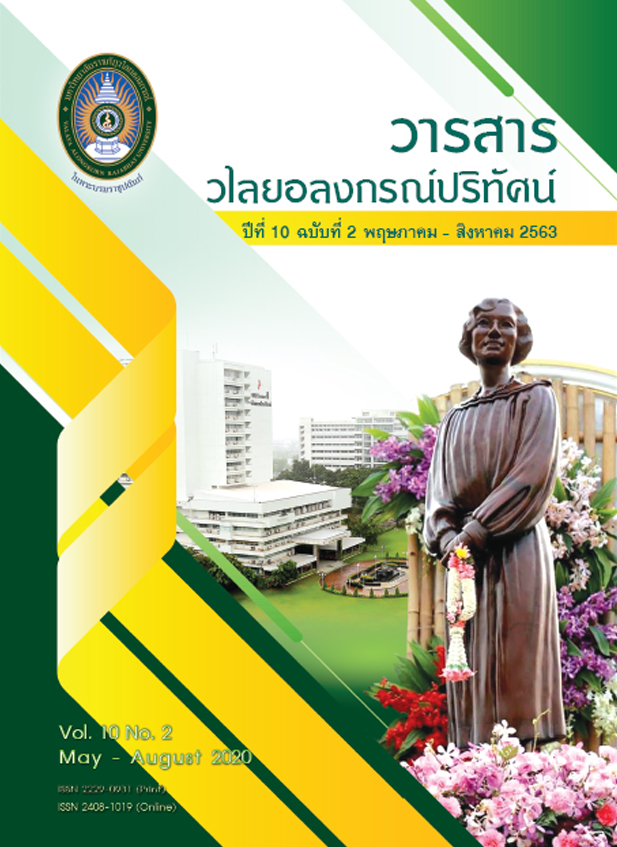กลวิธีการเรียนรู้คำศัพท์ภาษาอังกฤษของนักศึกษาชั้นปีที่ 1 ถึงชั้นปีที่ 3 มหาวิทยาลัยราชภัฏวไลยอลงกรณ์ ในพระบรมราชูปถัมภ์
คำสำคัญ:
กลวิธีการเรียนรู้คำศัพท์ภาษาอังกฤษคำศัพท์, คำศัพท์บทคัดย่อ
งานวิจัยนี้มีวัตถุประสงค์เพื่อ 1) ศึกษาการใช้กลวิธีการเรียนรู้คำศัพท์ภาษาอังกฤษของนักศึกษาชั้นปีที่ 1 ถึงชั้นปีที่ 3 มหาวิทยาลัยราชภัฏวไลยอลงกรณ์ ในพระบรมราชูปถัมภ์ และ 2) เปรียบเทียบการใช้กลวิธีการเรียนรู้คำศัพท์ภาษาอังกฤษของนักศึกษาทั้ง 3 ชั้นปี การศึกษาในครั้งนี้เป็นการวิจัยเชิงปริมาณ เครื่องมือที่ใช้ในการเก็บรวบรวมข้อมูลคือ แบบสอบถามกลวิธีการเรียนรู้คำศัพท์ภาษาอังกฤษโดยประยุกต์จากแนวคิดของ Schmitt (1997) และเก็บข้อมูลจากนักศึกษากลุ่มตัวอย่างจำนวน 330 คน ผลการวิจัยแสดงให้เห็นว่า โดยภาพรวมกลวิธีในการเรียนรู้คำศัพท์ที่นักศึกษาทั้ง 3 ชั้นปีใช้มากที่สุดคือ กลวิธีในการค้นพบ ส่วนผลการเปรียบเทียบแสดงให้เห็นว่านักศึกษาทั้ง 3 ชั้นปีใช้ทุกกลวิธีไม่แตกต่างกัน ยกเว้นกลวิธีในการค้นพบเท่านั้นที่นักศึกษาชั้นปีที่ 2 ใช้น้อยกว่านักศึกษาชั้นปีที่ 1 และปีที่ 3 อย่างมีนัยสำคัญทางสถิติ
References
สำนักงานเลขาธิการสภาการศึกษา. (2561). รายงานการศึกษาไทย พ.ศ. 2561. กรุงเทพฯ: สำนักงานเลขาธิการสภาการศึกษา กระทรวงศึกษาธิการ.
EF Education First. (2019) EF English Proficiency Index 2019. [Online], Available: https://www.ef.co.th/epi/. (2020, February 12)
Kirmizi, O. (2014). Measuring vocabulary learning strategy use of Turkish EFL learners in relation to academic success and vocabulary size. World Journal of Education. 4(6): 16-25.
Komol, T. & Sripetpun, W. (2011). Vocabulary Learning Strategies Employed by Undergraduate Students and its Relationship to their Vocabulary Knowledge. In The International Conference on Humanities and Social Sciences. The 3rd conference. 2 April 2011. (1-18). Songkla: Prince of Songkla University.
Larsen-Freeman, D. (2001). Individual cognitive/affective learner contributions and differential success in second language acquisition. In M. P. Breen (Ed.), Learner contributions to language learning. (1st ed). (pp 12-24). Harlow: Pearson Education.
McCarthy, M. (1990). Vocabulary. Oxford: Oxford University Press.
Mongkol, N. (2009). A study vocabulary learning strategies of the first and second year students from English department at Phetchaburi Rajabhat University. วารสารมนุษยศาสตร์ (มหาวิทยาลัยเกษตรศาสตร์). 16(1): 130-144.
Nacera, A. (2010). Languages learning strategies and the vocabulary size. Procedia - Social and Behavioral Sciences. 2: 4021-4025.
Nirattisai, S. (2014). Vocabulary Size and Vocabulary Learning Strategies of Thai University Students. Thesis in Master of Arts in Teaching English as an International Languages, Prince of Songkla University.
Schmitt, N. (1997). Vocabulary learning strategies. In Schmitt, N. & McCathy, M. (1997). Vocabulary: Description, acquisition and pedagogy. (pp.199-227). Cambridge: Cambridge University Press.
Schmitt, N. (2000). Vocabulary in language teaching. Cambridge: Cambridge University Press.
Schmitt, N. (2010). Researching Vocabulary: A Vocabulary Research Manual. New York, NY: Palgrave Macmillan.
Teng, M. F. (2015). Assessing the Relationship between Vocabulary Learning Strategy Use and Vocabulary Knowledge. PASAA. 49: 39-65.
Thornbury, S. (2002). How to teach vocabulary. Harlow: Pearson Education Limited.
Wallace, M. J. (1982). Teaching vocabulary. London: Heinemann Educational Books.
Yamane, T. (1967). Statistics: An Introductory Analysis. New York: Harper International Edition.
Yeh, C. Y. & Wang, Y. H. (2004). An Investigation into Vocabulary Learning Strategies Used by Senior High School Students in Taiwan. Taiwan Journal of TESOL. 1(2): 1-44.
Zimmerman, C. B. (1997). Historical trends in second language vocabulary instruction. In J. Coady & T. Huckin (Eds.), Second language vocabulary acquisition: A rationale for pedagogy. (1st ed). (pp. 5-19). Cambridge: Cambridge University Press.
Downloads
เผยแพร่แล้ว
How to Cite
ฉบับ
บท
License
ข้อความที่ปรากฏในบทความแต่ละเรื่องในวารสารวไลยอลงกรณ์ปริทัศน์ เป็นความคิดเห็นของผู้นิพนธ์แต่ละท่าน มิใช่เป็นทัศนะและมิใช่ความรับผิดชอบของกองบรรณาธิการจัดทำวารสาร และ
มหาวิทยาลัยราชภัฏวไลยอลงกรณ์ ในพระบรมราชูปถัมภ์

